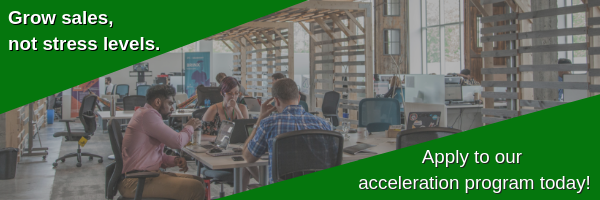Invest Ottawa sees thousands of entrepreneurs every year, all with an endless amount of ideas. But not all ideas are made equal, and the reality is, most will never be commercialized. So how can an entrepreneur increase the chances of turning a business idea into a business reality?

Ron Gagnier, Invest Ottawa Acceleration Program Specialist
Invest Ottawa specialist and advisor, Ron Gagnier, has been helping get entrepreneurial projects off the ground for decades, turning innovation into commercialization. In this three-part series, Ron walks through the dos and don’ts of product development and chats with FreightPath, an Invest Ottawa-supported company about how they have been able to avoid many of the most common missteps. Note: This is the final piece of his three-part blog series.
In Part 1 of this blog series, we explored the first of three common pitfalls typically faced by startups – Absence of Research (hint – if you haven’t already, read Part 1 here). Then, in Part 2 we unpacked the final two pitfalls, the Absence of Design and Absence of Feedback and Evaluation (if you haven’t already, read Part 2 here).
As a business advisor at Invest Ottawa, I have been working with FreightPath for a few months helping them to define their product strategy and ensure they are on track from a design standpoint. FreightPath, like most startups at Invest Ottawa, was founded by smart, high-energy entrepreneurs who not only have a great idea but nurture a strong drive and a passion for being successful.
Currently, Founder Gwenaël Malbec is building out a SAAS business othat is poised to transform the freight industry. So, how has FreightPath overcome the pitfalls many organizations fall prey too? I interviewed Gwen recently, and he offered valuable insight as to how their company has set themselves up to succeed.
Here is what he had to say:
Can you describe the biggest challenges the freight industry faces?
GWEN: We see more business functions moving away from transaction-focused tasks and moving towards a model where their employees are empowered to drive company objectives strategically. Technology is the force behind this.
Historically, freight companies would be staffed with individuals processing shipment requests, booking carriers, and collecting the necessary documentation to close loops. Technology can automate all of these tasks. Furthermore, the industry isn’t just made up of large conglomerates. It also consists of many small to medium sized businesses who need to focus on their core offerings. That’s where FreightPath comes in. Our solution allows these organizations to compete with the large companies.
How was the journey you experienced when building the software?
G: Harry (my partner) and I began in late 2015. We thought we had an edge with our “brilliant” idea and wanted to keep that competitive advantage by being first to market. However, being fast and being right are not always aligned.
We were surrounded by professionals from the freight industry but had no prior understanding of what things, such as a “minimum viable product” was or an understanding of different methodologies like a “lean startup,” this meant we spent hours with the development team adding functions that remained untouched by users.
Our software ended up being a suite of very cool, innovative features with a beautiful front-end but it could not be used efficiently in an operational environment. This was the most expensive lesson of my life.
What caused you to avoid doing research early on?
G: We missed how important integration would be with the systems being used by the freight industry. We chose to bring a product to market that we thought would revolutionize an industry without talking/sharing what we thought was too much information with the outside world. We were not challenged, or we were not letting ourselves be challenged.

Gwen Malbec
What changed for you? What caused you to recognize the need for research and to act?
G: What changed, was that there was no other way for us to be successful. So, we started gathering feedback from transportation professionals. We focused on two or three key points of friction and addressed them. We stopped making assumptions.
Every theory we have is now consistently backed by dozens of interviews with selected professionals. We put our egos aside and acknowledged that we are here to help customers with their challenges. Since then we have seen positive changes in feedback from our pilot users.
Another driver was financial. We simply could not afford to add features without being able to monetize immediately. Our old way of working caused us to iterate a feature many times before finally bringing value to our customers. We decided to go “lean” and build minimal features which were then made live. We moved forward with little wins and in hindsight that was valuable training for us. By incrementally adding small vital features, we shaped the state-of-the-art product we have today.
What was your first attempt at a software product like? When did you realize something wasn’t quite right? Did you know how to fix it?
G: Our first product, called pickmyload.com was very different from the current product. After two months of operations and minimal interest, we were accepted into a Montreal-based incubator. It was a wake-up call.
We had been doing things incorrectly every step of the way. The biggest takeaway for was, “Your product is as successful as the value you bring to your customers.” Fixing this has then been a two-year process. We’ve done interviews with hundreds of industry professionals, this has set us on a much clearer path.
Were there things you wish you had known from the customer that would have been useful during development?
G: The concept of pickmyload.com was mostly a freight marketplace which was designed to help shippers find verified carriers. The first customers were almost always dropping off after a couple of tries. Shippers were waiting too long to see their freight move and eventually, lost interest. Our platform also did not account for the “relationships/trust” factor of the freight transportation industry, which end users said was crucial.
Some freight brokers shared their experiences with us while using our platform and it turned out our process was inefficient and confusing. I remember one of these freight brokers directing me to a competitor’s page, as an example of how it “should” be done.
How is FreightPath using research today? What techniques have you employed (customer interviews, job shadowing, artifact analysis, data analytics, etc.)?
G: We wanted to understand what worked, what did not, and what friction our customers were facing the most in their day-to-day activities. We created customized questionnaires for each customer segment. We’ve had constant follow-ups with them either in-person or by video conference. After hundreds of interviews, we started to see a clear pattern. We finally understood what commercial carriers and brokers were looking for.
Market research confirmed the key trends we discovered during our interviews. To that end, Invest Ottawa and their Market Insight team have been instrumental in providing us with a value that far exceeded our expectations.
While developing our latest product, we really wanted to have every step of the design phase validated by operational transportation professionals. Our joint venture with Tretan Inc. has helped us tremendously. Every screen has been evaluated by Tretan Inc.’s director of operations and his team. The flow of our screens has been dictated by real-life scenarios of moving freight most efficiently. In the end, we had ten times fewer features than the first product we developed, yet had more positive feedback from the customers.
How is FreightPath defining their products? What techniques have you employed (customer journey mapping, personas, task analysis, scenarios, goal & needs models, wireframes, concepts workflows, etc.)?
G: We follow the Lean Startup Approach by-the-book. The first step was to draw the different industry segments, define buyer personas, understand their specific challenges, and identify unique value propositions which can help them in daily operations.
After weeks of iterations, it finally made sense to us that shippers do not fall in one bucket of professionals with the same challenges. Parameters like volume shipped, commodity type and shipping lanes, were all used to refine our product roadmap.
No single line of code was developed until we could identify an industry segment where we saw a significant need for our ideas, or a sizable Total Addressable Market (TAM). This change resulted in the mapping of our target segment’s daily business processes in a very optimized way.
With a clear understanding of the industry and a chosen industry segment, we designed wireframes of what our SaaS Transportation System would look like. After repeating the design/evaluation feedback cycle numerous times, we finalized a set of wireframes to incorporate into a mock workflow of the solution. Our workflows were validated using much of the same process. It was after this entire process when we finally began to write our first lines of code.
What are the short-term and long-term goals for FreightPath?
G: Half of our 2018 milestones have been achieved. We have released three major features of our platform, and we are generating revenue.
We are also in discussions with a large Canadian 3PL (Third Party Logistic) to implement our software for their entire operations. And we are currently scoping and planning a project which will make us a key player of cloud-based transportation management systems in Canada. We are living our dream, and hoping opportunities like these will continue to happen more frequently.
What was learned by FreightPath about the importance of avoiding common software pitfalls? Is there any advice you can provide to other entrepreneurs or start-ups?
G: I would advise all entrepreneurs to talk to as many potential clients as possible before engaging any expenses in design and development. Until you hear the famous “shut-up and take my money” sentence, keep on iterating on who you want to serve, understand their most impactful challenges, and how you can fix their problems.







